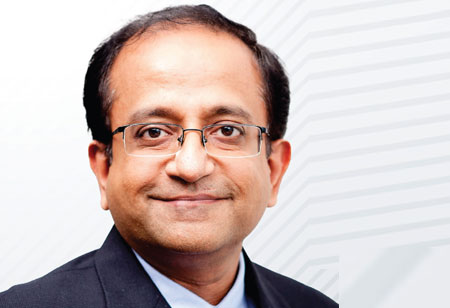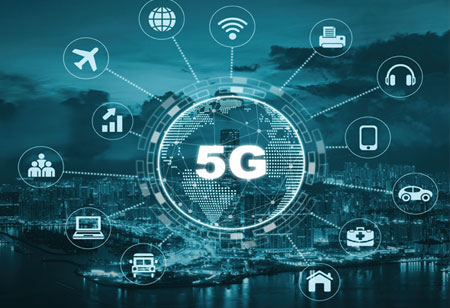
India's Digital Transformation Future In This Tech-Ade


Ramkumar Narayanan, VP- Technology & Managing Director, Vmware, 0
While we look forward to a fantastic future, Ramkumar Narayanan, VP-Technology and Managing Director, VMware, who is also a NASSCOM Executive Council member and NASSCOM Product Council Chairperson, walks us through the emerging trends in the digital transformation industry. A global leader focusing on data-driven, digital product innovation spanning consumer and enterprise markets, Ramkumar brings an unparalleled experience in product development, management & marketing, having led both new market entries and turnaround of existing business areas. He has been an advisor to large and small enterprises in digital transformation, product strategy, and product marketing.
In conversations with Ramkumar Narayanan, VP-Technology and Managing Director, VMware.
According to IDC, India’s public cloud services market is expected to grow 24.1 percent CAGR to reach $10.8 billion by 2025. What are the key factors influencing this projection?
As far as the business realm is concerned, one of the most significant outcomes of the pandemic was every company started to think about digital transformation and what it means for themselves. Right at the beginning of the pandemic, a lot of progress toward digital and just starting in the direction became a clear distinction between companies and their own ability to withstand the pandemic.
The work culture hosted a paradigm shift from local work station based models to work from home and hybrid models. It’s widely regarded as the future. It requires you to deliver an overwhelming employee and customer experience through the cloud. This became an accelerant to cloud adoption.
As you pointed out, public cloud spending in India alone is expected to grow multifold to $13.5 billion by 2026. If you look at the global numbers, the total cloud spending was $410 billion in 2020-21 and is projected to increase to $490 billion by the end of 2022. We are talking about an $80 billion hike in one year, which is over a 20 percent increase.
Today, we at VMware are at an exciting juncture. As a software company, we are the largest private cloud provider in the world, and we have a vast base of customers in markets worldwide, including India. We also have deep-rooted partnerships with the public cloud providers like Amazon, Microsoft, and Google. It gives us a unique perspective to not only understand the dynamic trends in the market but cater to them in an advanced way. We call ourselves the Switzerland of the cloud space for our customers since we are the only neutral party with a partnership with all the cloud providers.
Another significant trigger for cloud spending is Application migration, which allows organizations to shift their unique applications built in different technology eras to the latest computing environments.
How is 5G deployment going to influence the cloud space, and what does this mean for VMware?
With the arrival of 5G,the entire telco infrastructure is becoming software defined. Going forward, telcos will require a cloud at the edge. Hence, every telco tower will probably have a small data center running at the base of it. VMware not only brings to the table the software defined cloud expertise and VMware Cloud Foundation (a unified SDDC platform that brings together VMware’s vSphere, vSAN, and NSX into a natively integrated stack), which brings the entire cloud stack that can be deployed anywhere. But we also have a telco organization as part of VMware that is looking at particular applications of the telco cloud, right from the endpoint, the service delivery level, all the way back to the data centers. Furthermore, we were working with several telco providers worldwide, their suppliers, and software vendors regarding their 5G deployments and enabling many of these applications on our infrastructure.
Cyber attackers have thrived in the aftermath of the digital transformation rush. How do you perceive this ever growing threat landscape?
It’s an undeniable truth that with the sky rocketing digital transformation trends and people continuing to work from home the attack vector into the infrastructure has gone up dramatically. The world is now moving towards a zero trust approach. It basically means that you treat any entry point into your network, whether it is somebody working from home, working from a coffee shop, or using their laptop or mobile devices, you treat them inherently, assuming that they could be dangerous in terms of a potential cyber attack.
On the other hand, there’s been a significant shift in cyber security solutions about how you protect an environment and your employees in a non-intrusive way, which means that you don’t have to remember a dozen different passwords every hop is completely transparent. The software installed on my device tells my network that this is a node device committed. Where as if some body
comes in with an unknown device and tries to connect, a lot of services will not be available. Even though I may not be able to check my email or access files, it would still give me a fair experience.
The third aspect is creating awareness. Both employers and employees need to stay abreast of the latest security information.For example our Chief Information Security Officer and his team constantly remind our workforce how to avoid phishing attacks or what things to watch out for. You also need to educate your customers, especially since they also use their mobile phones significantly.
VMware has a robust partner ecosystem, including a huge clientele of some of the biggest banks worldwide. We have set up their digital infrastructure and helped them with their cloud journey, in addition to catering our products in the cyber security space both at the network and endpoint levels. We take great pride in our products and their built-in AI driven security features.
Tell us about your leadership approach. What guide lines and methodologies do you follow as an experienced leader in this space?
I am an inclusive leader. I like to hear a lot of perspectives and encourage my team to disagree with me a lot of times. Hearing the contrarian point of view helps a lot in effective decision-making. At the end of the day, I have a strong perspective on how to move forward. On the other hand, once you have formed a solid vision for the future, you have to get people to believe in your vision and bring them along. In fact, there is no shortcut to achieving this. It takes intact and frequent communication, explaining to people why we need to move forward in a specific direction. Your strategy and execution need to go hand in hand.

Going forward, what are the opportunities you foresee and the areas that VMware focuses on? Also, as an industry expert whose responsibilities go beyond VMware, how do you perceive the trends and changes in market behavior?
VMware is strictly aligned with the dynamics of the digital space and extremely focused on helping our customers throughout their cloud journey, enabling them to move from on premise to private or public clouds. Today, most organizations have at least a couple of cloud environments that they use simultaneously more than one layer of redundancy. Hence, we are also focused on providing them with the management infrastructure required to manage the multi cloud environment. The other aspects include security, employee experience, and end user experience, among others. We wear industry hats beyond ‘VMware.’
We have also signed MoUs with several state governments to work with their startup initiatives to help in the areas like education and cyber security. Hence, as a company and a part of India’s broader ecosystem, we see an exciting future.

I am a part of the NASSCOM Executive Council, which gives me a holistic view of how India as an ecosystem is evolving. I also chair the national product council. Deep tech’s emergence in India is one of the explosive trends we witness. The industry now perceives a much larger view of different tech combinations under the umbrella of Deeptech. It cuts across various debates around everything from rocket science to cybersecurity and autonomous vehicles & drones to agritech. There are about 3000 Deeptech companies in India today. NASSCOM’s Deep Tech Club has about 1000 of them as members. Our goal is to enable 1000 more big tech startups. We already have about 250 to 300 startups in our fold.
Ram kumar Narayanan, VP -Technology & Managing Director, VMware
A global leader focusing on data-driven, digital product innovation spanning consumer and enterprise markets, Ramkumar brings an unparalleled experience in product development, management & marketing, having led both new market entries and turnaround of existing business areas. He has been an advisor to large and small enterprises in digital transformation, product strategy, and product marketing.
Hobbies: is a vivid reader. He reads and writes about leadership. He also reads a lot about technology as well as climate change. Following what interests him at any given time makes him host several hobbies.
Favorite book:The Ministry for the Future (his current favorite), a Novel by Kim Stanley Robinson
The third aspect is creating awareness. Both employers and employees need to stay abreast of the latest security information.For example our Chief Information Security Officer and his team constantly remind our workforce how to avoid phishing attacks or what things to watch out for. You also need to educate your customers, especially since they also use their mobile phones significantly.
VMware has a robust partner ecosystem, including a huge clientele of some of the biggest banks worldwide. We have set up their digital infrastructure and helped them with their cloud journey, in addition to catering our products in the cyber security space both at the network and endpoint levels. We take great pride in our products and their built-in AI driven security features.
With the arrival of 5g, the entire telco infrastructure is becoming software defined. Going forward, telcos will require a cloud at the edge. Hence, every telco tower will probably have a small data center running at the base of it
Tell us about your leadership approach. What guide lines and methodologies do you follow as an experienced leader in this space?
I am an inclusive leader. I like to hear a lot of perspectives and encourage my team to disagree with me a lot of times. Hearing the contrarian point of view helps a lot in effective decision-making. At the end of the day, I have a strong perspective on how to move forward. On the other hand, once you have formed a solid vision for the future, you have to get people to believe in your vision and bring them along. In fact, there is no shortcut to achieving this. It takes intact and frequent communication, explaining to people why we need to move forward in a specific direction. Your strategy and execution need to go hand in hand.

Going forward, what are the opportunities you foresee and the areas that VMware focuses on? Also, as an industry expert whose responsibilities go beyond VMware, how do you perceive the trends and changes in market behavior?
VMware is strictly aligned with the dynamics of the digital space and extremely focused on helping our customers throughout their cloud journey, enabling them to move from on premise to private or public clouds. Today, most organizations have at least a couple of cloud environments that they use simultaneously more than one layer of redundancy. Hence, we are also focused on providing them with the management infrastructure required to manage the multi cloud environment. The other aspects include security, employee experience, and end user experience, among others. We wear industry hats beyond ‘VMware.’
We have also signed MoUs with several state governments to work with their startup initiatives to help in the areas like education and cyber security. Hence, as a company and a part of India’s broader ecosystem, we see an exciting future.

I am a part of the NASSCOM Executive Council, which gives me a holistic view of how India as an ecosystem is evolving. I also chair the national product council. Deep tech’s emergence in India is one of the explosive trends we witness. The industry now perceives a much larger view of different tech combinations under the umbrella of Deeptech. It cuts across various debates around everything from rocket science to cybersecurity and autonomous vehicles & drones to agritech. There are about 3000 Deeptech companies in India today. NASSCOM’s Deep Tech Club has about 1000 of them as members. Our goal is to enable 1000 more big tech startups. We already have about 250 to 300 startups in our fold.
Ram kumar Narayanan, VP -Technology & Managing Director, VMware
A global leader focusing on data-driven, digital product innovation spanning consumer and enterprise markets, Ramkumar brings an unparalleled experience in product development, management & marketing, having led both new market entries and turnaround of existing business areas. He has been an advisor to large and small enterprises in digital transformation, product strategy, and product marketing.
Hobbies: is a vivid reader. He reads and writes about leadership. He also reads a lot about technology as well as climate change. Following what interests him at any given time makes him host several hobbies.
Favorite book:The Ministry for the Future (his current favorite), a Novel by Kim Stanley Robinson